
At dawn on Sunday, June 25, 1950, the Korean People’s Army crossed the 38th parallel behind artillery fire. The KPA justified its assault with the claim that ROK troops attacked first and that the KPA were aiming to arrest and execute the “bandit traitor Syngman Rhee”. Fighting began on the strategic Ongjin peninsula in the west. There were initial South Korean claims that they captured the city of Haeju, and this sequence of events has led some scholars to argue that the South Koreans fired first. Whoever fired the first shots in Ongjin, within an hour, North Korean forces attacked all along the 38th parallel. The North Koreans had a combined arms force including tanks supported by heavy artillery. The South Koreans had no tanks, anti-tank weapons or heavy artillery to stop such an attack. In addition, South Koreans committed their forces in a piecemeal fashion and these were routed in a few days.
On June 27, Rhee evacuated from Seoul with some of the government. That same day, United States President Harry S. Truman ordered U.S. air and sea forces to help the South Korean regime. On June 28, at 2 am, the South Korean Army blew up the Hangang Bridge across the Han River in an attempt to stop the North Korean army. The bridge was detonated while 4,000 refugees were crossing it and hundreds were killed. Destroying the bridge also trapped many South Korean military units north of the Han River. In spite of such desperate measures, Seoul fell that same day. A number of South Korean National Assemblymen remained in Seoul when it fell, and forty-eight subsequently pledged allegiance to the North.
The government of the Democratic People’s Republic of Korea (조선민주주의인민공화국 — Chosŏn Minjujuŭi Inmin Konghwaguk) uses June 25 as the kick-off date for the annual “Struggle Against U.S. Imperialism Month” which runs until July 27. It’s a time in which North Koreans flock to war museums such as the Sinchon Museum of American War Atrocities and gather to take action against the “evils” of the United States. Over 100,000 gather in Pyongyang’s Kim II Sung Stadium to speak out against “the fatty monster U.S. imperialists” as part of the ‘Mass Rally on the Day of the Struggle Against the U.S.”, An stamp issue has been a part of the anti-American celebrations off-and-on since 1952, with most featuring images taken from fairly graphic propaganda posters. I find these stamps quite fascinating and, yes, despite the June 12, 2018, summit between U.S. President Donald Trump and 3rd Supreme Leader of the DPRK Kim Jong-un (김정은) in Singapore, North Korea did release this year’s set right on schedule. However, news reports this week indicate that the anti-American souvenirs once sold on the North Korean side of the Demilitarized Zone have disappeared from gift shop shelves.

I should mention here that I consider myself a patriot, a proud American who supports the history of the Republic and the ground it sits upon rather. I count among my ancestors at least two who fought in the American Revolutionary War, one of which was the only non-Mason pall-bearer at George Washington’s funeral. I support the U.S. military and fervently wish that all of our troops currently serving could return home without being placed in harm’s way. I have also lived outside of the United States as an expatriate for the past fourteen years (and have yet to return even for a brief visit) and have seen how the government’s policies are viewed from abroad. While I feel, as so many others seem to think, that the current administration is floundering (I voted Libertarian in the last election), this month’s actions by President Trump and Premier Kim has offered a glimmer of hope to this cynical observer. However, I am still amused (morbidly fascinated?) by the anti-American images on the posters, postcards and postage stamps.
Although hostility between the two countries remains largely a product of Cold War politics, there were earlier conflicts and animosity between the U.S. and Korea. In the mid-19th century Korea closed its border to Western trade. In the General Sherman incident, which took place in 1866, Korean forces attacked a U.S. gunboat sent to negotiate a trade treaty and killed its crew, after fire from both sides because it defied instructions from Korean officials. A U.S. retribution attack, the Shinmiyangyo, followed.
Korea and the U.S. ultimately established trade relations in 1882. Relations soured again in 1905 when the U.S. negotiated peace at the end of the Russo-Japanese War. Japan persuaded the U.S. to accept Korea as part of Japan’s sphere of influence, and the United States did not protest when Japan annexed Korea five years later. Korean nationalists unsuccessfully petitioned the United States to support their cause at the Versailles Treaty conference under Woodrow Wilson’s principle of national self-determination.
The United Nations divided Korea after World War II along the 38th parallel, intending it as a temporary measure. However, the breakdown of relations between the U.S. and USSR prevented a reunification. During the U.S. Army’s occupation of South Korea, relations between the U.S. and North Korea were conducted through the Soviet military government in the North. Because of North Korea’s “submission” to Soviet pressures, and because of mass opposition to the U.S. occupation of the mortal enemy Japan, North Koreans in this period denounced the United States and began to form a negative view of the U.S. However, several American ministers and missionaries remained active in this period.
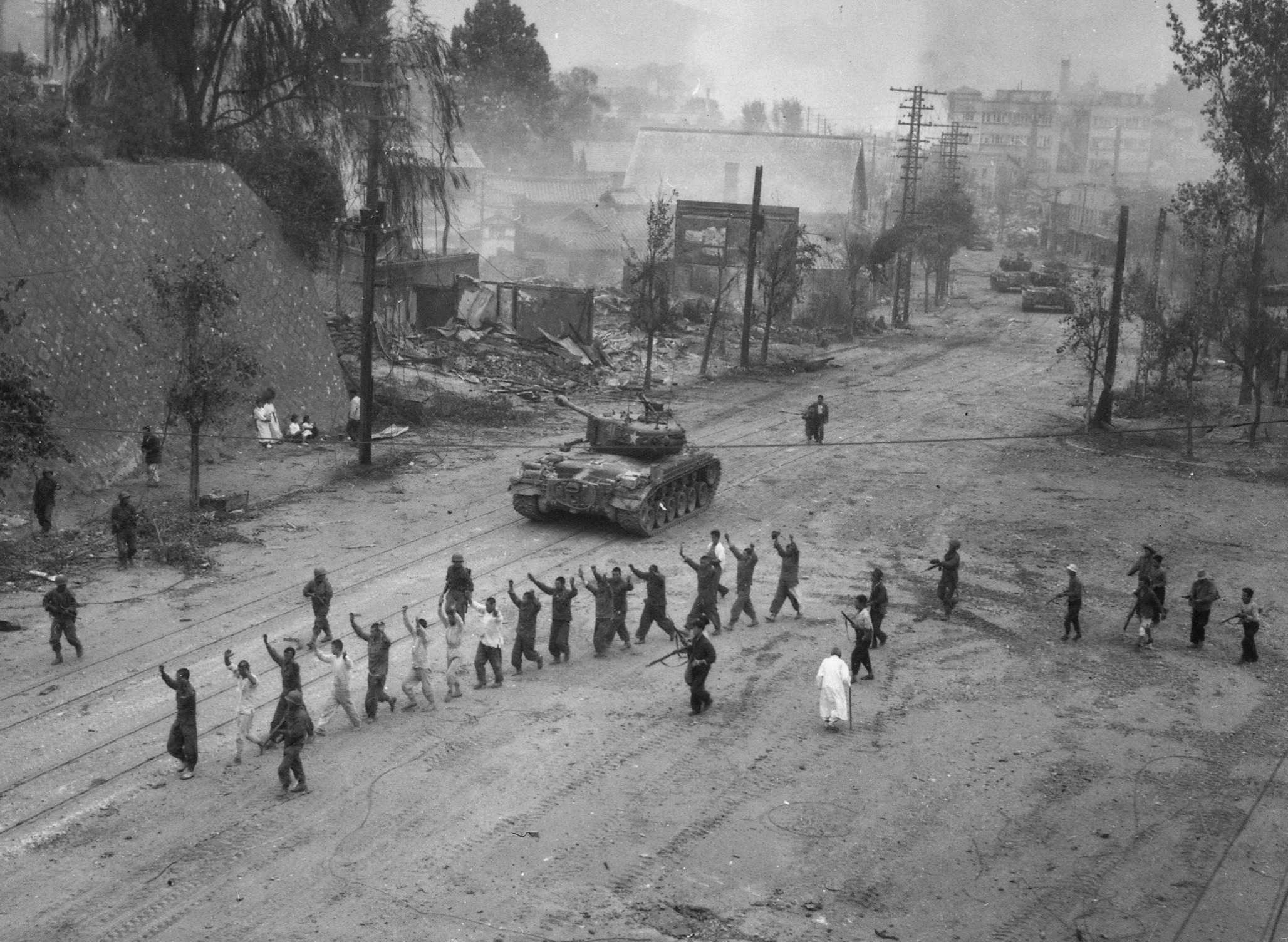
On September 9, 1948, Kim Il-sung declared the Democratic People’s Republic of Korea; he promptly received diplomatic recognition from the Soviet Union, but not the United States. The U.S. did not extend, and has never extended, diplomatic recognition to the DPRK. Kim Il-Sung’s anti-American rhetoric often asserted that the U.S. was a capitalist imperialist successor to Japan, a view the country still holds today. In December 1950, the United States initiated economic sanctions against the DPRK under the Trading with the Enemy Act, which lasted until 2008.
North Koreans had their closest encounter with the United States during the U.S./UN occupation of North Korea in the two months after the Inchon landing. With help from the ROK Army, the United States’ military, under the command of General Douglas MacArthur, moved to set up a civil administration for North Korea in the wake of the presumed defeat of North Korea. MacArthur planned to find North Korean generals, especially Kim Il-Sung, and try them as war criminals.
Public support in the United States to commit ground troops to Korea was at first, remarkably high. In June 1950, 78% of Americans said they approved of Truman’s decision to send military aid, and 15% disapproved. As soon as January 1951, public support for the war had plummeted to 38%
In the early 1960s, several American soldiers defected to North Korea. Only one, Charles Jenkins, returned to the United States and faced a U.S. military court, pleading guilty to charges of desertion and aiding the enemy. Jerry Parrish, Larry Abshier and James Dresnok died of natural causes in North Korea.
Some leafleting of North Korea was resumed after the heavy leafleting that took place in the Korean War, such Operation Jilli from 1964 to 1968. One leaflet was on one side a good reproduction of a North Korean one won note, about six weeks’ pay for an ordinary North Korean soldier, and on the other a safe conduct pass for defection to the south. The rationale was to allow soldiers to easily hide the pass, but the quality was sufficient for it to gain some use as a fraudulent banknote in North Korea.
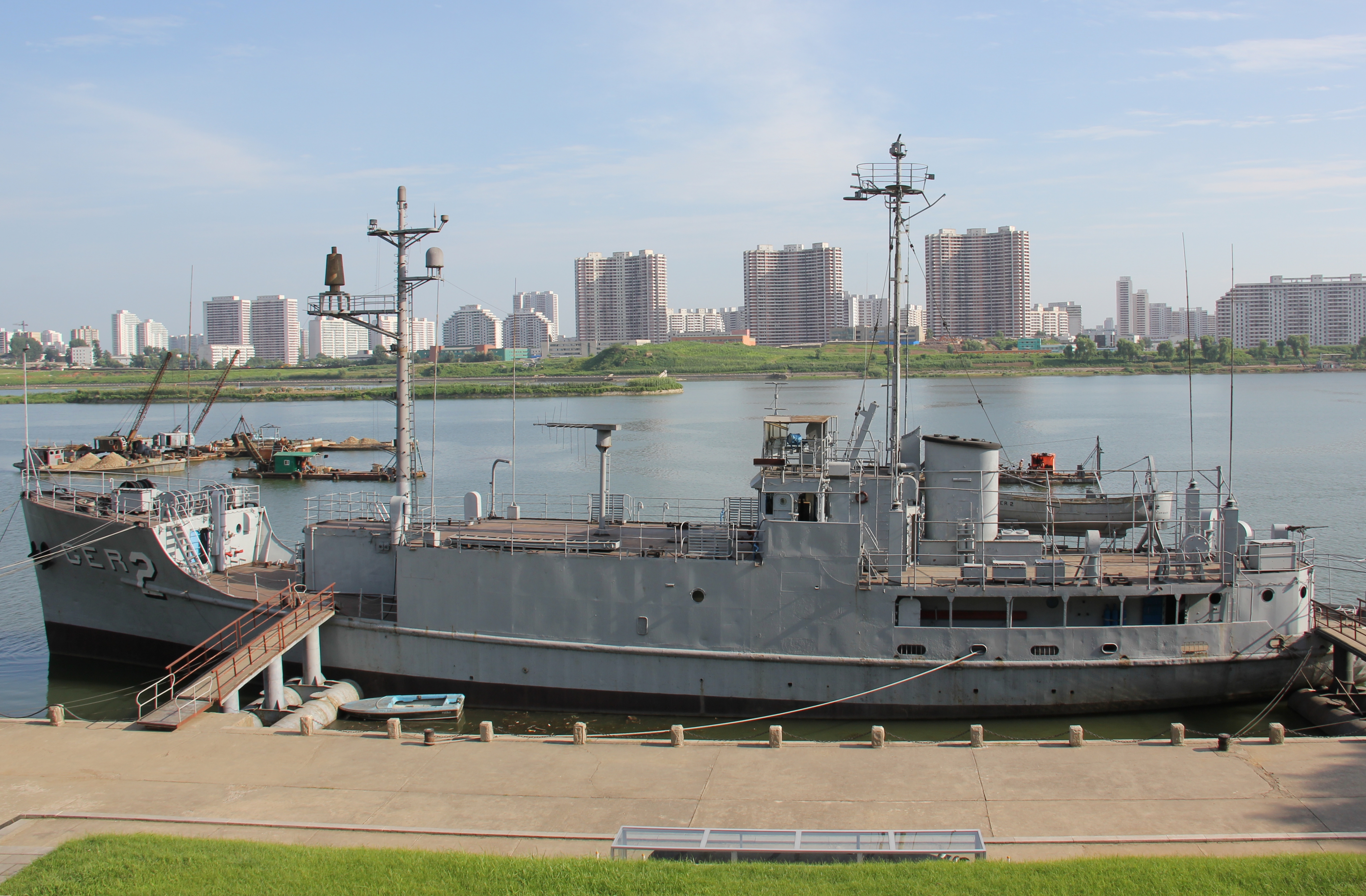
On January 23, 1968, a U.S. spy ship was captured. The incident was known as the Pueblo incident. On April 15, 1969, EC-121 was shot down over the Sea of Japan by North Korea; 31 American service men died.
On August 18, 1976, Captain Arthur Bonifas and Lieutenant Mark Barrett were killed by the North Korean Army with axes at Panmunjom in the Korean Demilitarized Zone, when the Americans were engaged in routine tree-clearing. The attack coincided with a meeting of the Conference of Non-Aligned Nations in Colombo, Sri Lanka, at which Kim Jong-il, the son of North Korean leader Kim Il-sung, presented the incident as an example of American aggression, helping secure the passage of a motion calling for a U.S. withdrawal from the South. The Ford administration decided that it was necessary to respond with a major show of force. The North Korean government backed down and allowed the tree-cutting to go ahead, and later issued an unprecedented official apology.
North Korea and the United States had little to no relations during this time, except through the structures created by the Korean Armistice Agreement.
In 1994, North Korea blocked international inspectors from verifying the regime’s adherence to the Nuclear Nonproliferation Treaty. The Bill Clinton administration believed that the North Koreans were processing plutonium from a reactor to build two atomic bombs. President Clinton recalled that “I was determined to prevent North Korea from developing a nuclear arsenal, even at the risk of war”. According to former Pentagon officials, the Clinton administration drew plans to strike the North Korea nuclear reactor at Yongbyon.
In December 1994, a US OH-58 Kiowa helicopter was shot down over North Korea, a pilot died and another was captured by North Korea and held for 13 days.
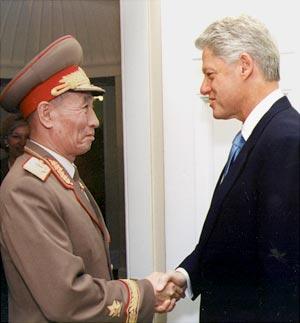
In December 2002, Spanish troops boarded and detained a shipment of Scud missiles from North Korea destined for Yemen, at the United States’ request. After two days, the United States released the ship to continue its shipment to Yemen. This further strained the relationship between the U.S. and North Korea, with North Korea characterizing the boarding an “act of piracy”.
In September 2005, immediately following the September 19 agreement, relations between the countries were further strained by allegations of North Korean counterfeiting of U.S. dollars. The United States alleges that North Korea produces $15 million worth of supernotes every year, and has induced banks in Macau and elsewhere to end business with North Korea. Such claims of counterfeiting date back to 1989, so the timing of the U.S. claims is suspect. Some experts[ doubt North Korea has the capacity to produce such notes, and U.S. financial auditors have been analyzing records seized from the Macau bank and have yet to make a formal charge. In 2007, it was reported that an audit by Ernst & Young had found no evidence that the bank had facilitated North Korean money-laundering.
At various times during the Bush administration Dong Moon Joo, the president of The Washington Times, undertook unofficial diplomatic missions to North Korea in an effort to improve relations.
On February 13, 2007, agreement in the Six-Party Talks — among the United States, the two Koreas, Japan, China, and Russia — called for other actions besides a path toward a denuclearized Korean peninsula. It also outlined steps toward the normalization of political relations with Pyongyang, a replacement of the Korean Armistice Agreement with a peace treaty, and the building of a regional peace structure for Northeast Asia.

In exchange for substantial fuel aid, North Korea agreed to shut down the Yongbyon nuclear facility. The United States also agreed to begin discussions on normalization of relations with North Korea, and to begin the process of removing North Korea from its list of state sponsors of terrorism. Implementation of this agreement has been successful so far, with U.S. Chief Negotiator Christopher R. Hill saying North Korea has adhered to its commitments. The sixth round of talks commencing on March 19, 2007, discussed the future of the North Korean nuclear weapons program.
In early June 2008, the United States agreed to start lifting restrictions after North Korea began the disarming process. President Bush announced he would remove North Korea from the list of state sponsors of terrorism after North Korea released a 60-page declaration of its nuclear activities. Shortly thereafter, North Korean officials released video of the demolition of the nuclear reactor at Yongbyon, considered a symbol of North Korea’s nuclear program. The Bush administration praised the progress, but was criticized by many, including some within the administration, for settling for too little. The document released said nothing about alleged uranium enrichment programs or nuclear proliferation to other countries.
The United States public has historically favored diplomatic approaches over military ones in regards to North Korea. Framing of the North Korean conflict is what is widely believed to have led to such widespread support for a diplomatic approach among the American people.
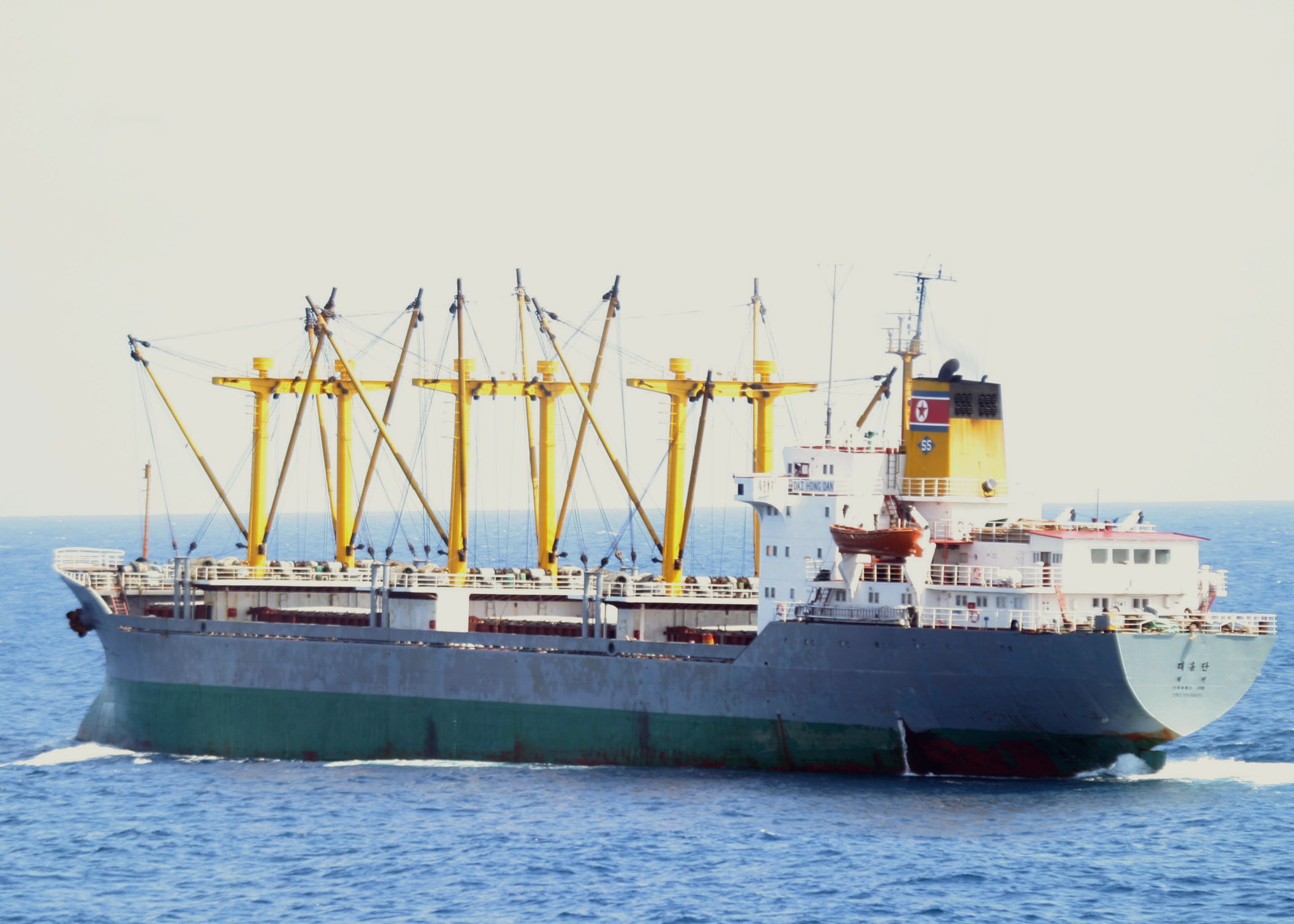
On November 4, 2007, Dai Hong Dan, a North Korean merchant vessel, was attacked by Somali pirates off the coast of Mogadishu who forced their way aboard, posing as guards. As U.S. Navy ships patrolling the waters moved to respond, the 22 North Korean seamen fought the eight Somali pirates in hand-to-hand combat. With aid from the crew of the USS James E. Williams and a helicopter, the ship was freed, and permission was given to the U.S. crew to treat the wounded crew and pirates. This resulted in favorable comments from U.S. envoy in Beijing, Christopher R. Hill, as well as an exceedingly rare pro-U.S. statement in the North Korean press. The favorable result of the incident occurred at an important moment, as the North Koreans moved to implement the February 13 agreement with the acquiescence of the Bush Administration, and the 2007 South Korean presidential election loomed, with the North Koreans taking pains to emphasize a more moderate policy.
In February 2008, the New York Philharmonic visited North Korea. The concert was broadcast on North Korean television.
American-North Korean relations were further strained by the arrest of two American journalists on March 17, 2009. The two journalists, Euna Lee and Laura Ling of Current TV, were arrested on the North Korean border in China while supposedly filming a documentary on the trafficking of women and allegedly crossing into North Korea in the process. North Korea subsequently tried the two journalists amid international protests and found them guilty of the charges, and sentenced them to twelve years of hard labor. The U.S. criticized the act as a “sham trial”.
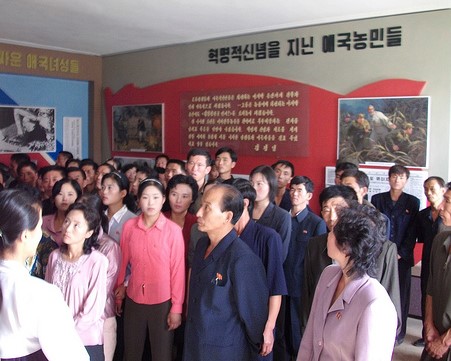
The ordeal was finally resolved on August 4, when former President Bill Clinton arrived in Pyongyang in what he described as a “solely private mission” to secure the release of the two American journalists. He reportedly forwarded a message to North Korean leader Kim Jong-il from then-U.S. President Barack Obama, but White House Press Secretary Robert Gibbs denied this claim. Clinton’s discussions with Kim were reportedly on various issues regarding American-North Korean relations. On August 5, Kim issued a formal pardon to the two American journalists, who subsequently returned to Los Angeles with Clinton. The unannounced visit by Clinton was the first by a high-profile American official since 2000, and is reported to have drawn praise and understanding by the parties involved.
On May 24, 2010, the United States set plans to participate in new military exercises with South Korea as a direct military response to the sinking of a South Korean warship by what officials called a North Korean torpedo.
On May 28, 2010, the official (North) Korean Central News Agency stated that “it is the United States that is behind the case of ‘Cheonan.’ The investigation was steered by the U.S. from its very outset.” It also accused the United States of manipulating the investigation and named the administration of U.S. President Barack Obama directly of using the case for “escalating instability in the Asia-Pacific region, containing big powers and emerging unchallenged in the region.” The report indicated to the United States to “behave itself, mindful of the grave consequences.”
In July 2010, the DPRK government indefinitely postponed a scheduled talk at Panmunjom relating to the sinking. The meeting was intended as preparation for future talks at higher governmental levels.
Just over two years later on March 16, 2012, North Korea announced it would launch its Kwangmyŏngsŏng-3 satellite to mark the 100th anniversary of the late Kim Il-sung’s birthday. This announcement triggered American anxiety as satellite launches are technologically contiguous with missile launches. This tampered with Kim Jong-un’s earlier optimistic overtures and generated speculation on the issues confronting the new and young leader back in North Korea. The United States also suspended food aid to North Korea in retaliation for the missile plans.
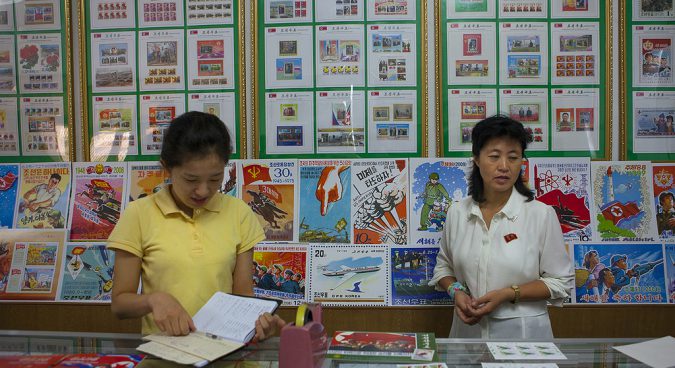
Daniel Russel, Special Assistant to the President and Senior Director of Asia, and Sydney Seiler flew to Pyongyang from Guam in August 2012 and stayed there for two days. A South Korean diplomatic source said “apparently President Barack Obama, who was then bidding for a second term in office, secretly sent the officials to North Korea to minimize disruptions to the U.S. presidential election.” Other analysts say, “Nobody can rule out that such direct dialogue between Washington and Pyongyang will continue in the future.”
However, on December 11, 2012, North Korea successfully launched a missile in contrast to its failure in March. The United States strongly condemned the action as it is widely believed that North Korea are developing long range ballistic missiles that would reach the west coast of the U.S.
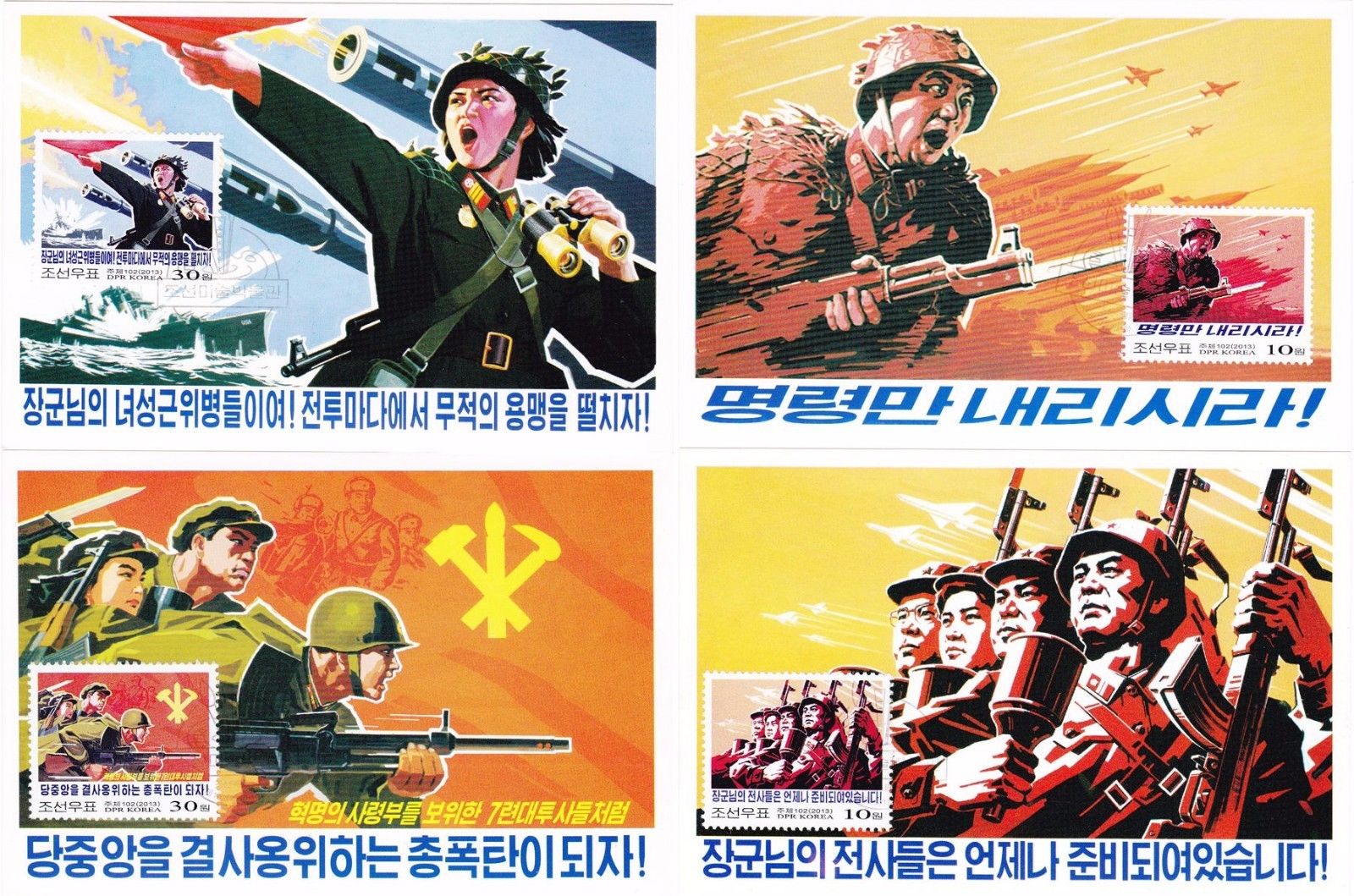
On March 29, 2013, Kim Jong-un threatened the United States by “declaring that rockets were ready to be fired at American bases in the Pacific.” The declaration was in response to two B2 stealth bombers that flew over the Korean peninsula on the day before. After Jong-un’s declaration, the Pentagon called for an advanced missile defense system to the western Pacific on April 3. United States Secretary of Defense, Chuck Hagel, said that North Korea posed “a real and clear danger” to not only the United States, but Japan and South Korea as well. The deployment of the battery to the U.S. territory of Guam is the biggest demonstration yet that Washington regards the confrontation with North Korea as more worrying than similar crises of the past few years. It also suggested they are preparing for long standoff. While visiting Seoul, South Korea on April 12, 2013, United States Secretary of State, John Kerry, said “North Korea will not be accepted as a nuclear power”, and that a missile launch by North Korea would be a “huge mistake”. On April 18, 2013, North Korea issued conditions for which any talks would take place with Washington D.C. or Seoul. They included lifting United Nations sanctions and an end to United States-South Korean Military exercises.
On April 26, 2013, North Korea said it had arrested a U.S. citizen for committing an unspecified crime against the country. U.S. officials said that person was Kenneth Bae. On May 2, 2013, Bae was convicted of “hostile acts” and sentenced to 15 years of hard labor. The U.S. called for his release but North Korea rejected any possibility of allowing prominent Americans to visit the country to request his release. Dennis Rodman, who had previously visited North Korea and become friends with Kim Jong-un, tweeted a plea for Bae’s release. On May 2, 2014, Pyongyang’s Korean Central News Agency (KCNA) released an article composed of four essays written by North Korean citizens. The content of the article carried heavy criticism and racist remarks towards U.S. President Barack Obama.
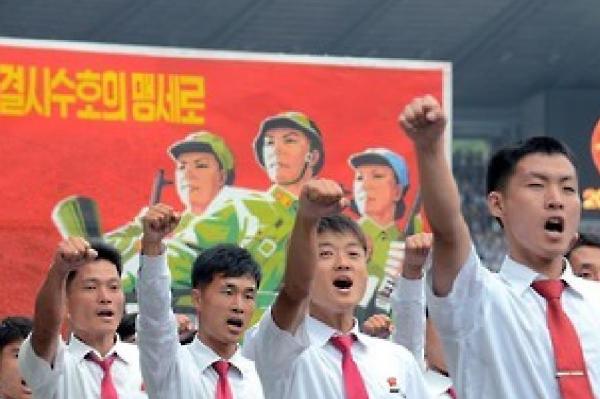
Two American citizens were detained in North Korea in June 2014, accused of “hostile acts”. On July 28, 2014, the United States House of Representatives voted to pass the North Korea Sanctions Enforcement Act of 2013 (H.R. 1771; 113th Congress), but it was never passed by the Senate. On August 20, 2014, during annual U.S.-South Korea military drills, a spokesman for the North Korean government referred to U.S. Secretary of State John Kerry as a “wolf donning the mask of sheep”, the latest in an exchange of taunts between U.S., South Korean and North Korean government officials. In January 2015, U.S. President Barack Obama indicated that he believed that over time the North Korean government will collapse. On July 28, 2016, a North Korean top diplomat for U.S. affairs claimed that the United States crossed the “red line” for putting leader Kim Jong-un on its list of sanctioned individuals, which was perceived by officials as the United States declaring war.
Following the April 7, 2017, U.S. missile strikes in Shayrat, Syria, in response to a chemical attack, tensions had mounted as U.S. President Donald Trump weighed further military options against North Korea’s ballistic missile program. In the second week of April 2017, global media outlets erroneously reported that the USS Carl Vinson supercarrier had been deployed to the Sea of Japan heading towards North Korea, as a result of confusion created by a “miscommunication” between the “Pentagon and the White House.” A premature announcement on April 8 from the Navy led to a “glitch-ridden sequence of events”. On April 17, North Korea’s deputy United Nations ambassador accused the United States of “turning the Korean peninsula into “the world’s biggest hotspot” and the North Korean government stated “its readiness to declare war on the United States if North Korean forces were to be attacked.”
![[url=https://flic.kr/p/Lmx9iN][img]https://farm2.staticflickr.com/1836/29112104128_284985bfb8_o.jpg[/img][/url][url=https://flic.kr/p/Lmx9iN]Borth Korea - Struggle Against US imperialism Month - 2018-4[/url] by [url=https://www.flickr.com/photos/am-jochim/]Mark Jochim[/url], on Flickr](https://farm2.staticflickr.com/1836/29112104128_284985bfb8_o.jpg)
President Trump called Mr Kim “Little Rocket Man” and a “sick puppy”, and promised that continued North Korean threats to America “will be met with fire and fury like the world has never seen”. Trump called diplomacy with the Kim regime “a waste of time”. In reality on April 18, the Carl Vinson and its escorts were 3,500 miles from Korea engaged in scheduled joint Royal Australian Navy exercises in the Indian Ocean. In late April 2017, Trump stated that “[t]here is a chance that we [the United States] could end up having a major, major conflict with North Korea”. In July 2017, U.S. Secretary of State Rex Tillerson authorized a “Geographical Travel Restriction” which banned Americans from entering North Korea.
An American citizen by the name of Tony Kim, also known by the Korean name of Kim Sang-duk, was detained while attempting to leave North Korea through Pyongyang International Airport. In January 2016, an American student, Otto Warmbier, was detained at Pyongyang International Airport after allegedly attempting to steal a propaganda banner from his hotel. He was traveling with a group of Americans, all of whom safely returned to America without any conflict, while he was stopped by security and searched. Security footage showed him allegedly going into a banned area in the hotel and ripping out the poster from the wall and putting it in his bag. He claims that he was following orders from his church to take something from North Korea back to the church. In March 2016, he was sentenced to 15 years of hard labor, but in June 2017 was released from North Korea, having suspiciously fallen into a coma-like state. He died a few days after being repatriated to the U.S. North Korea claimed that they had nothing to do with his death. The Chinese travel company that took Warmbier to North Korea as part of a tourist group has stated that it will no longer accept American citizens on its tours to prevent similar circumstances from happening. After Americans heard about Warmbier’s death, 49% wanted the administration to act, while 35% did not. Of those Americans who wanted action to be taken, the most popular response was for the U.S. to tighten sanctions on North Korea, and the second most popular was a total travel ban between the two countries. United States military action was the least popular response.
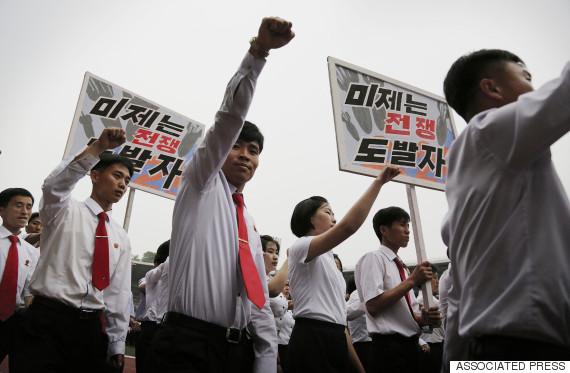
In August 2017, the Washington Post reported on a confidential assessment carried out by the U.S. Defense Intelligence Agency which suggested that North Korea had successfully developed nuclear warheads for missiles within reach of the U.S. mainland. Reacting to the report, President Trump stated that future threats would be “met with fire and fury and frankly power, the likes of which this world has never seen before.” In response, North Korea announced that it was examining an operational plan to strike areas around the U.S. territory of Guam in the Pacific, including the Andersen Air Force Base. Officials stated that Joseph Y. Yun, the U.S. envoy for North Korea policy, and Pak Song-il, a senior North Korean diplomat at the country’s UN mission, were making regular contact during this dispute, through a conduit of communication they called the New York channel.
On August 8, 2017, President Trump suggested that the United States was prepared to inflict “fire and fury” against North Korea if they failed to cease nuclear testing and threats. In response, North Korea issued a series of threats against the U.S. territory of Guam as well as allies such as Japan and South Korea. Two missiles were flown over Japanese territory and a nuclear test was conducted.
In a speech to the United Nations General Assembly in September 2017, Trump threatened to “totally destroy” North Korea if the United States were “forced to defend itself or its allies”; he repeated his recent nickname for Kim Jong-un as “Rocket Man”. In response North Korean leader Kim Jong-un called the speech “unprecedented rude nonsense” and “mentally deranged behavior”.
On September 23, 2017, the U.S. military flew B-1B bombers from Guam, along with F-15C Eagle fighter escorts from Okinawa, Japan flew in international airspace over waters east of North Korea. Unlike on previous missions, the U.S. aircraft were not accompanied by South Korean or Japanese planes. Afterward North Korea said a missile strike against the U.S. is “inevitable all the more”.
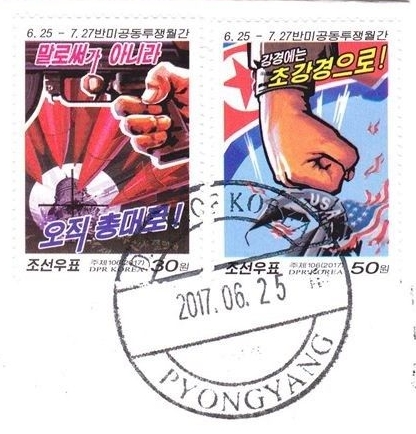
On September 30, 2017, U.S. Secretary of State Rex Tillerson said the U.S. and North Korea were in “direct contact”, and “probing” the possibility of talks.
On October 9, 2017, U.S. Air Force B-1 bombers carried out mock missile launches off both coasts of South Korea. Two bombers operating out of Andersen Air Force Base in Guam carried out the drills along with fighter jets from the South Korean and Japan militaries. This was the first nighttime B-1 bomber exercise between the three allies.
On November 28, 2017 North Korea fired an intercontinental ballistic missile and it was the first such launch from the rogue regime in more than two months. The missile, believed to be an ICBM by the U.S. Military, was launched from Sain Ni, North Korea and flew roughly 620 miles before landing in the Sea of Japan.
In his New Year address for 2018, North Korean leader Kim Jong-un celebrated completing their nuclear capabilities and proposed talks for sending a delegation to the upcoming Winter Olympics in South Korea. In January a false missile alert alarmed Hawaii. The Seoul–Pyongyang hotline was reopened after almost two years. North Korea sent an unprecedented high-level delegation to the PyeongChang Olympics, headed by Kim Yo-jong, sister of Kim Jong-un, and President of the Presidium of the Supreme People’s Assembly Kim Yong-nam, and including performers like the Samjiyon Orchestra. The delegation passed on an invitation to President Moon to visit North Korea. The United States was represented by Vice President Mike Pence. After arriving late to a dinner hosted by President Moon, he was asked to greet the other dignitaries, but he shook hands with everyone except Kim Yong-nam and left early. North and South Korean athletes marched together in the Olympics opening ceremony and fielded a united women’s ice hockey team.

On March 5, 2018, South Korea’s special delegation agreed to hold the third inter-Korean summit at Inter-Korean Peace House in Panmunjom on April 27, 2018. On March 6, after returning to South Korea, the national security adviser, Chung Eui-yong, and National Information Director Suh Hoon traveled to the United States on March 8 to report to Trump about the upcoming inter-Korean summit and relayed to Trump the North Korean leader Kim Jong-un’s invitation. Trump endorsed the North Korea–United States summit about an hour after receiving the report. The South Korean National Security Adviser (SKNS), Mr. Jeong briefed the public that the North Korea–United States summit would be held sometime in May 2018. Chung Eui-yong revealed that Kim Jong-un had expressed “eagerness” to meet with the President. The move was described by South Korean President Moon Jae-in as a “miracle.”
Kim Jong-un was in Beijing from March 25–28, arriving by special train for talks with China’s paramount leader Xi Jinping, Kim’s first known out-of-country excursion since taking power six years previously. China stated that North Korea was “committed to denuclearization” and willing to hold a summit with the United States. It was organized by the invitation of Xi. During the meeting between two leaders, Kim officially invited Xi to the North Korean capital Pyongyang when it was convenient in his schedule, and Xi accepted the invitation. Xi urged Kim to strengthen the strategic and diplomatic future partnership between China and North Korea. Kim stressed to Xi that North Korea and China are communist countries and that there are many ways to cooperate in various aspects in the future. Kim and Xi met again on May 7, 2018, in the city of Dalian, China.

On April 11, North Korea presented five entreaties as conditions for the dismissal of their nuclear-capable ICBMs:
- Ensuring the United States and South Korea do not locate nuclear weapons strategic assets within the vicinity of the Korean Peninsula
- Ceasing development or operation of strategic nuclear assets during USFK–ROK combined military training
- Ensuring the United States will not attack North Korea with conventional or nuclear weapons
- Converting the 1953 Korean Armistice Agreement into a peace treaty on the Korean Peninsula
- Establishing official diplomatic ties between North Korea and the United States.
Although North Korea was previously expected to request the withdrawal of United States Forces Korea (USFK) from South Korea, North Korea publicized they would embrace the continuous deployment of 25,000 USFK troops in South Korea as long as the security of North Korea is guaranteed.

At an inter-Korean summit on April 27, held at the Peace House in Panmunjom, the leaders of North and South Korea agreed to formally end the Korean War before the end of the year and confirmed the goal of a nuclear-free Korean Peninsula through denuclearization.
On May 10, three Americans held by the North Korean regime were released following the advanced negotiations between the Trump administration and the North Korean regime. Some have speculated that their release was part of an attempt of the regime to motivate the U.S. to continue the negotiations and perhaps ease the pressure upon the North Koreans. Nevertheless, their release has managed to ease the tensions between the Trump administration and the North Korean regime, enabling both sides to proceed to further negotiations.
American Vice President Mike Pence said on May 21, 2018, that “this will only end like the Libyan model ended if Kim Jong-un doesn’t make a deal” to “dismantle his nuclear weapons program”. Trump had made similar remarks on May 17, as he described that Libya’s fate is “what will take place if we don’t make a deal”. These comments were in reference to the killing of Libyan leader Muammar Gaddafi after military intervention by Americans and Europeans in 2011. After a NATO airstrike prevented Gaddafi’s escape, the Libyan rebels captured, beat up, sodomized, and executed Gaddafi. However, Libya under Gaddafi had already in 2003 voluntarily ended its nuclear weapons program and complied with conditions set by Western powers. As a result, North Korean vice foreign minister Choe Son-hui called Pence’s remarks “ignorant and stupid” and threatened a “nuclear-to-nuclear showdown”.
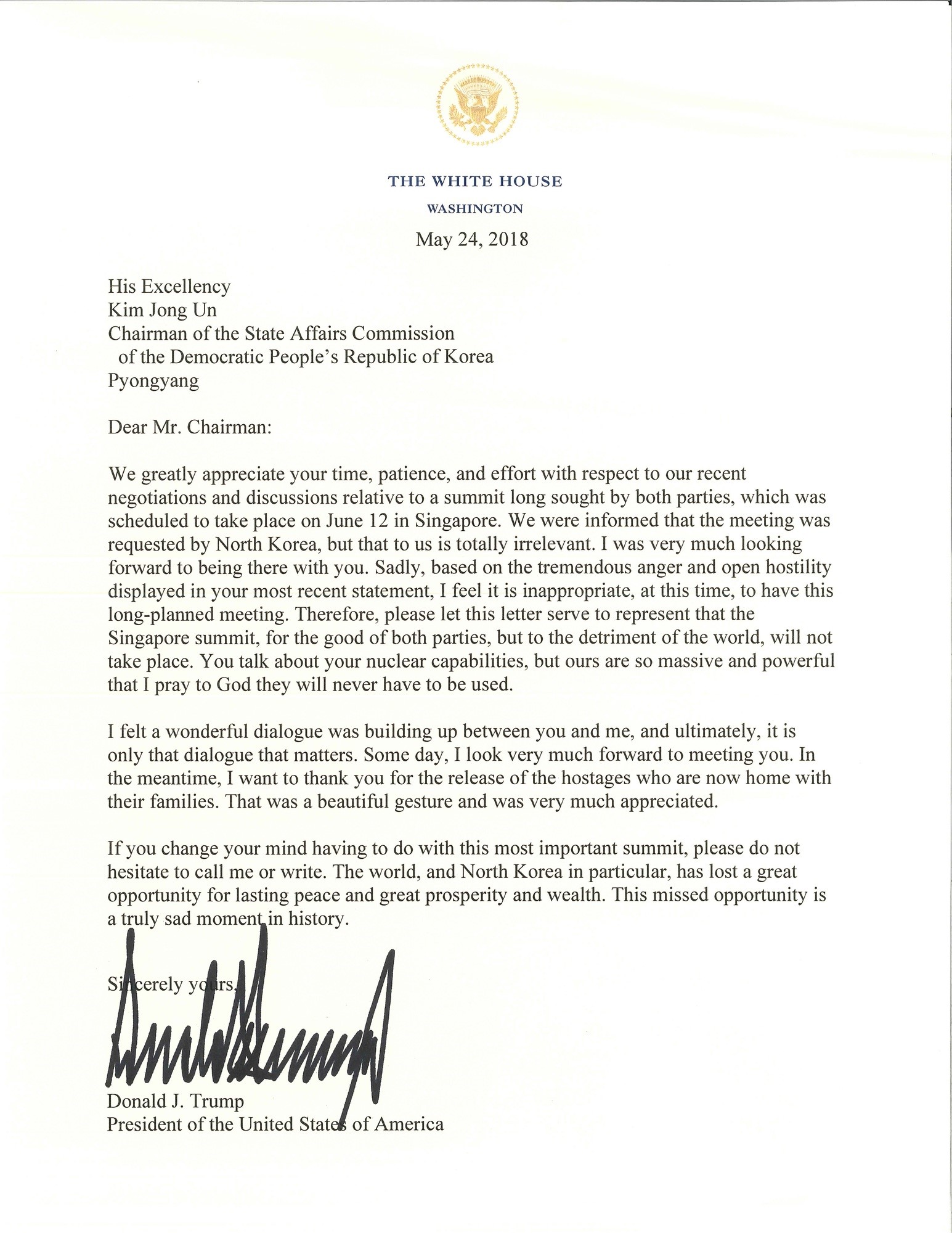
After military exercises between the United States and South Korea, Kim Jong-un threatened to pull out of the summit. Trump canceled the summit on May 24 via a letter to Chairman Kim, writing that “based on the tremendous anger and open hostility displayed in your most recent statement, I feel it is inappropriate, at this time, to have this long-planned meeting … You talk about your nuclear capabilities, but ours are so massive and powerful that I pray to God they will never have to be used.” Even though it was Trump who decided to cancel, Trump told Kim, “If you change your mind having to do with this most important summit, please do not hesitate to call me or write.”
South Korean President Moon was left “very perplexed” by Trump’s cancellation, while the South Korean minister in charge of inter-Korean affairs Cho Myoung-gyon said that North Korea “remains sincere” on “efforts on denuclearization and peace building”.
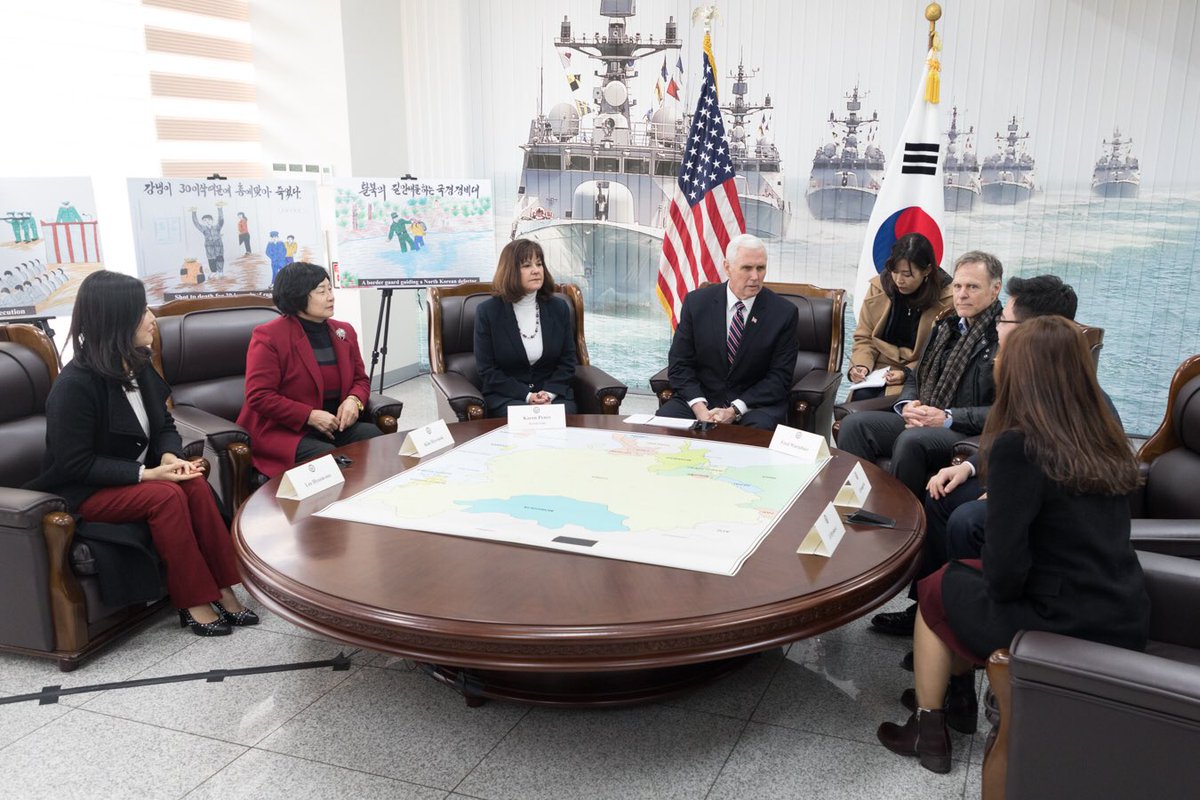
In response to Trump’s cancellation, North Korean vice foreign minister Kim Kye-gwan expressed his country’s “willingness to sit down face-to-face with the U.S. and resolve issues anytime and in any format”, being “open-minded in giving time and opportunity to the U.S.” for the “peace and stability for the world and the Korean Peninsula”. Trump’s cancellation had come on the day North Korea had detonated explosives at its only known nuclear test site, at Punggye-ri in front of international journalists; North Korea claimed that this would have demolished the test site.
On May 25, however, Trump announced that the summit could resume as scheduled following a “very nice statement” he received from North Korea and that talks were now resuming. The following day, White House Press Secretary Sarah Sanders confirmed in a statement that a “pre-advance team for Singapore will leave as scheduled in order to prepare the summit should take place”. The team, consisting of about thirty staffers from both the White House and State Department, met with North Korean counterparts over Memorial Day weekend.
On May 30, North Korean general Kim Yong-chol arrived in New York City to meet with U.S. Secretary of State Mike Pompeo. Negotiations between Kim and Pompeo continued the next day, and Pompeo later stated at a press conference that “good progress” had been made. Kim Yong-chol, who is the Vice Chair of Central Committee of the Workers’ Party of Korea, is the highest-ranking North Korean official to visit the U.S. since 2000 (when Jo Myong-rok met with President Bill Clinton in Washington, D.C.).
On June 1, Trump announced the summit would resume as scheduled for June 12 after he met Kim Yong-chol at the White House. Kim Yong-chol delivered a letter from Kim Jong-un to Trump, of which Trump first told reporters that it was “a very nice” and “a very interesting letter”, yet eight minutes later said “I haven’t seen the letter yet. I purposely didn’t open the letter”.
In early June, while Singapore conducted logistical preparations for the summit, the Singapore Mint released three commemorative medallions to mark the talks. They are available in gold proof, silver proof, and nickel plated zinc proof.
On June 9, the Singapore Police Force and the Land Transport Authority announced that security measures, such as road closures and security checks, would begin. Security checks were conducted along stretches of roads around the Shangri-La Hotel Singapore and the St Regis Hotel Singapore, the two hotels Trump and Kim were anticipated to stay in. On June 11, Singapore’s Minister for Foreign Affairs Vivian Balakrishnan announced that the Singapore government would be paying for the North Korean contingent’s hotel bill, forming part of the total U.S. $20 million expenditure for the summit, as it was “hospitality that we would have offered them”.
President Trump left the 44th G7 summit around four hours earlier than scheduled and departed directly for Singapore. He reportedly viewed the G7 summit as a “distraction” from his summit with Kim. Trump landed at Singapore’s Paya Lebar Airbase at 20:20 local time on June 10, and was welcomed by Singapore’s Minister for Foreign Affairs Vivian Balakrishnan. A U.S. Air Force Boeing C-17 Globemaster III transport plane was already at the air base ahead of his arrival. Trump stayed at the Shangri-La Hotel Singapore, which has also hosted previous U.S. Presidents.
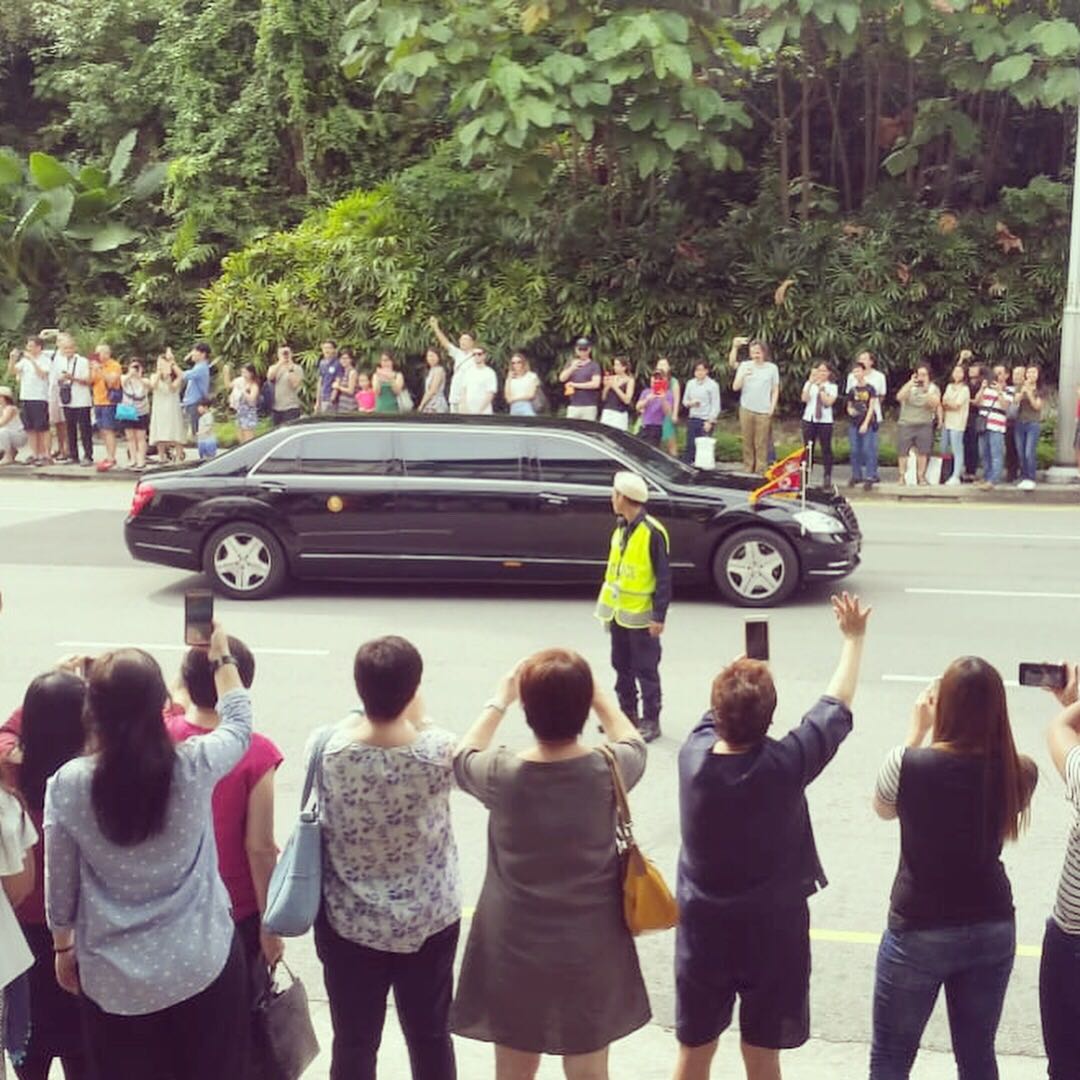
Kim Jong-un landed at Singapore Changi Airport on Sunday, June 10 at about 14:35 local time and was welcomed by Singapore’s Minister for Foreign Affairs Vivian Balakrishnan and Minister for Education Ong Ye Kung. Kim flew to Singapore on a Boeing 747 operated by Air China, a plane used by the highest echelons of the Chinese leadership. According to media reports, a cargo plane, an Air Koryo Ilyushin Il-76, containing food items and other perishables landed in Singapore from North Korea before Kim’s plane landed. Chiller trucks ferried them to the St. Regis Hotel Singapore where Kim stayed. A third plane from North Korea, an Air Koryo Ilyushin Il-62, landed shortly afterward; Kim’s sister and Vice Director of the Propaganda and Agitation Department, Kim Yo-jong, was believed to be on board.
Kim visited several of Singapore’s attractions in the Central Area together with his sister, Kim Yo-jong, on Monday evening. They visited the Flower Dome at Gardens by the Bay, the Jubilee Bridge, and the Marina Bay Sands integrated resorts. They were accompanied by Singapore’s Minister for Foreign Affairs Vivian Balakrishnan and Minister for Education Ong Ye Kung, the same ministers who welcomed him at the airport the previous day.
On Tuesday, June 12, 2018, North Korean leader Kim Jong-un arrived at Capella Hotel first before United States President Donald Trump arrived six minutes later. They started the summit at 9:05 am local time with a 12-second handshake and then participated in a one-on-one meeting, with interpreters only. Trump and Kim emerged from the one-on-one talks and walked down the corridor to the Cassia where the expanded bilateral meeting took place. Trump described the one-on-one meeting as “very very good” when asked by a reporter. When Trump was asked if he had notes of the one-on-one meeting to refer back and verify, Trump replied, “I don’t have to verify because I have one of the great memories of all time”.
Both countries’ delegations proceeded to participate in an expanded bilateral meeting and a working lunch. Both delegations dined together on Korean, Southeast Asian and Western dishes with ice cream, tropézienne, and dark chocolate tartlet ganache as dessert. After the lunch, Trump and Kim took a short walk together and viewed the interior of the presidential state car.
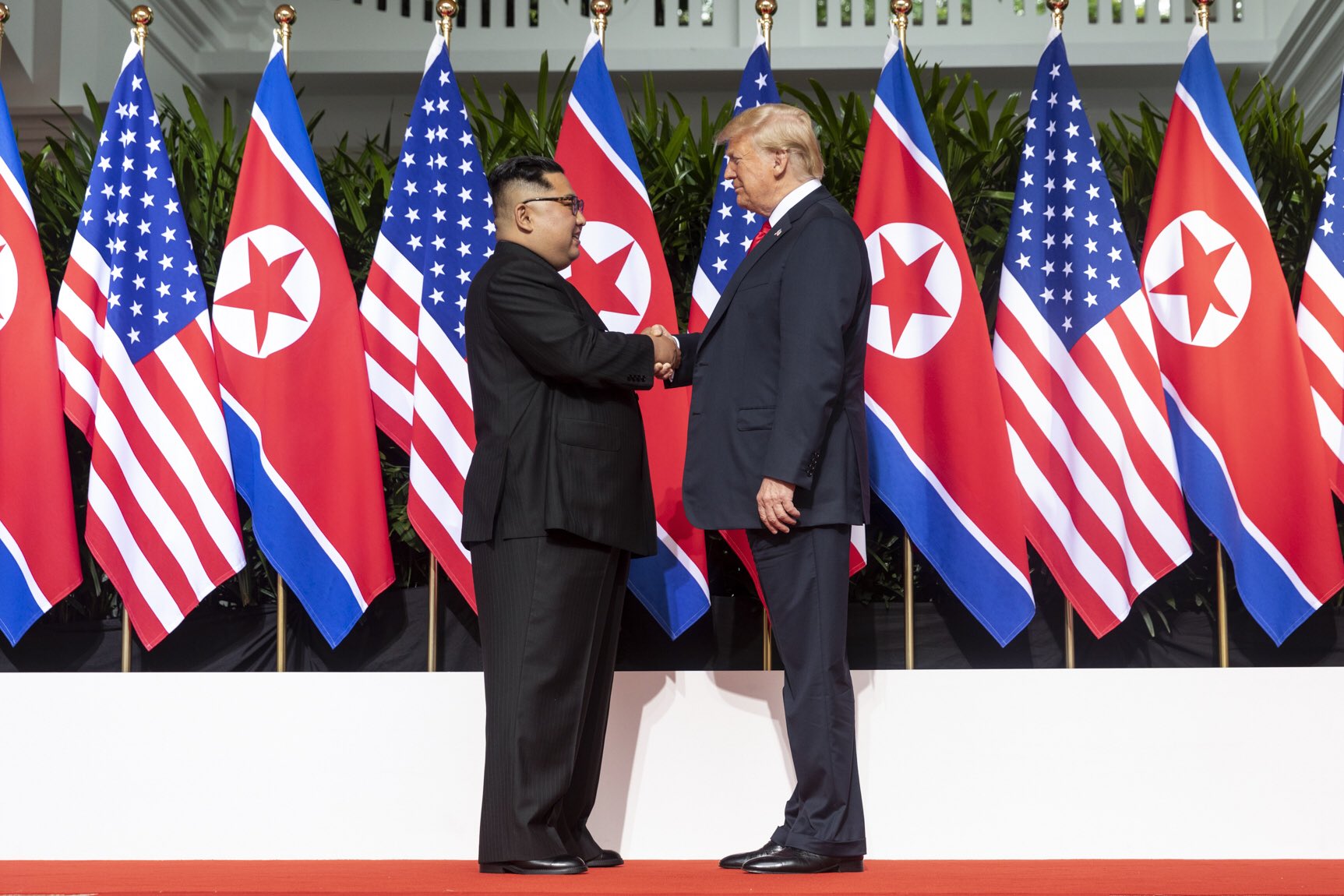
Subsequently, Trump and Kim signed a joint statement, titled “Joint Statement of President Donald J. Trump of the United States of America and Chairman Kim Jong-un of the Democratic People’s Republic of Korea at the Singapore Summit”, which Trump described as a “very important” and “comprehensive” agreement. The document said:
President Trump and Chairman Kim Jong Un state the following:
- The United States and the DPRK commit to establish new U.S.-DPRK relations in accordance with the desire of the peoples of the two countries for peace and prosperity.
- The United States and the DPRK will join their efforts to build a lasting and stable peace regime on the Korean Peninsula.
- Reaffirming the April 27, 2018 Panmunjom Declaration, the DPRK commits to work towards the complete denuclearization of the Korean Peninsula.
- The United States and the DPRK commit to recovering POW/MIA remains including the immediate repatriation of those already identified.
In addition to the numbered provisions, the joint statement also mentions Trump’s commitment to providing security guarantees to North Korea. Follow-up negotiations between Pompeo and an undetermined high-level North Korean official are also called for by the joint statement.
Trump held a news conference at 16:15 local time which lasted for more than an hour. In his news conference, Trump said that further discussions will take place with North Korean officials and that he would consider visiting Pyongyang. Referring to his commitment in the Joint Statement to “provide security guarantees” to North Korea, Trump announced the end of the joint military exercises with the South Korean military, which he described as “provocative”. U.S. Forces Korea and South Korea were apparently not consulted. He expressed his hope that the removal of 32,000 American troops defending South Korea would become part of the equation. The next round of joint military exercises was scheduled for late August.
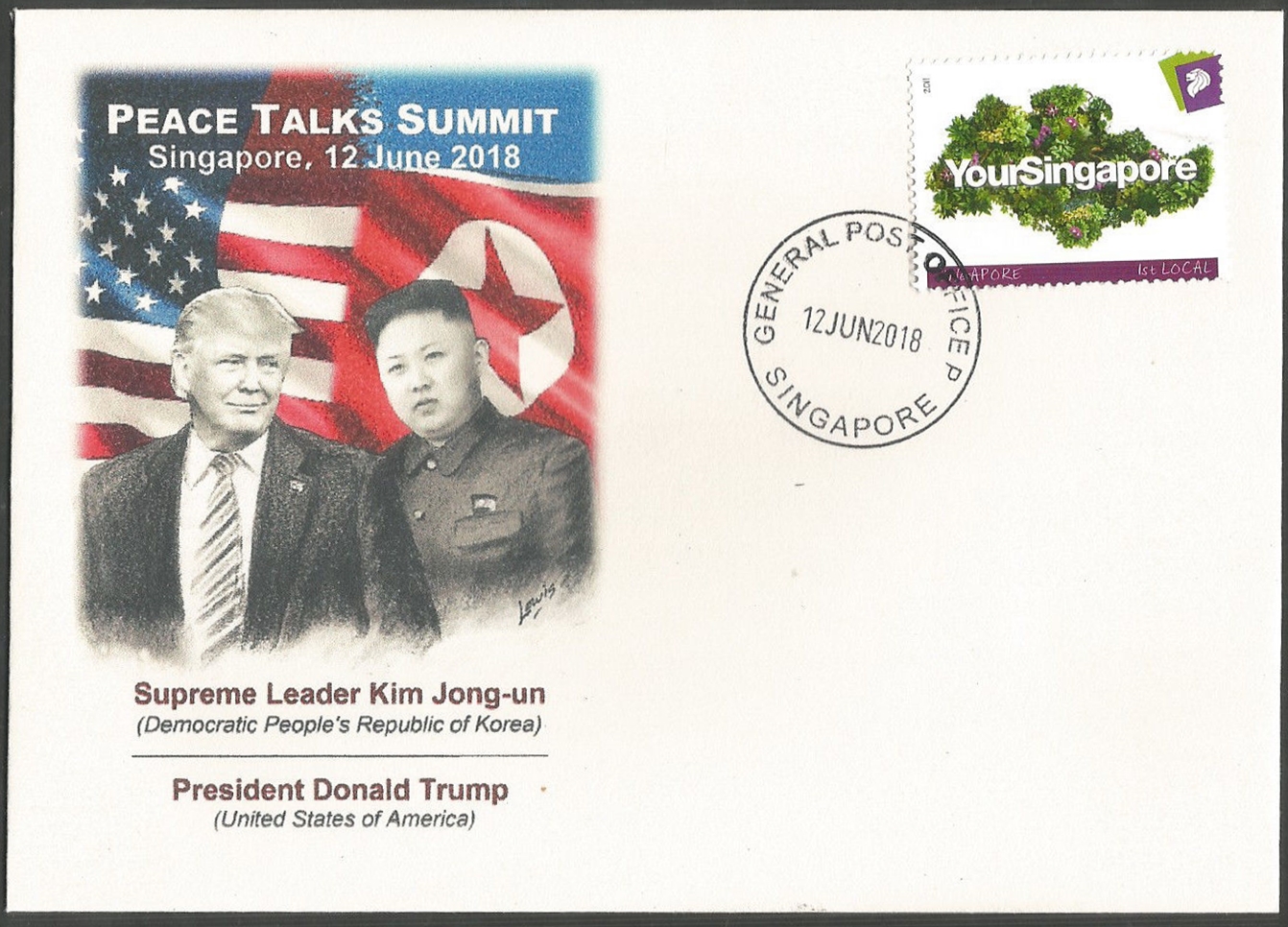
On June 12, Trump left Singapore from Paya Lebar Air Base at around 18:30 local time, earlier than his planned departure time of 19:00 while Kim Jong-un left Singapore from Changi Airport at around 22:30.
Upon returning to the United States the following day, President Trump declared that North Korea was no longer a nuclear threat. On June 22, Trump provided a “Notice Regarding the Continuation of the National Emergency with Respect to North Korea,” which extended the Executive Order 13466 of 2008 by one year, reaffirming “the current existence and risk of the proliferation of weapons-usable fissile material on the Korean Peninsula constitute an unusual and extraordinary threat to the national security and foreign policy of the United States, and I hereby declare a national emergency to deal with that threat.”

North Korea’s state media declared a new era of peace following the summit. Reports emerged on June 23 that North Korea was removing anti-U.S. propaganda. According to Rowan Beard of Young Pioneer Tours; “All the anti-American posters I usually see around Kim Il-sung Square and at shops, they’ve all just gone. In five years working in North Korea, I’ve never seen them completely disappear before.”
On June 24, Trump stated that North Korea still posed an ‘extraordinary threat’ to the U.S. and maintained sanctions on the country despite declaring them no longer a threat the day following the summit.
The Korea Stamp Corporation (조선의 체신체계 — Chosŏnŭi ch’e*sinch’kye) or Korean Post (조선 우편 — Chosŏn uyyŏn), operated by the Ministry of Post and Telecommunications and Communication Maintenance Bureau, issued the 2018 set of stamps for “Struggle Against U.S. Imperialism Month” earlier this year, probably before the first announcements of the summit. There are four denominations this year (2017 saw just two) and are available in both perforated and imperforate form. With the current thawing of North Korean-U.S. relations, this could very well be the last in a long series of anti-American stamps issued by the DPRK beginning with a single 10-won rose stamp released on June 4, 1952. marking the “Day of Anti-U.S. Imperialist Struggle” (Scott #53). Two stamps were released on June 1, 1953, for the same “holiday” (Scott #64-65) but was back to a single on June 10, 1954 (Scott #77) before being skipped philatelically for the next four years.

A set of four anti-American stamps were released on June 25, 1959 (Scott #172-175) with designs calling for the withdrawal of U.S. troops from South Korea. By 1963, the “Day of Struggle” had become an entire month and June 25 of that year saw the release of the first multicolored anti-U.S. stamp (Scott #464)/ The 1964 stamp featured Koreans as well as a statue of war hero Kang Yo Yong (Scott #526). The lowest denomination in a three-stamp set for the Korean Reunification Campaign released on August 15, 1966, featured a Korean attacking a U.S. soldier (Scott @719). The four-stamp set issued on June 25, 1967, portrayed military sculpture (Scott @783-786). By 1960, the anti-American stamps weren’t restricted to the June issues; one notable design marked the International Conference of Journalists Against U.S. Imperialism depicting a green-faced Richard Nixon speared by a flurry of fountain pens released on September 18, 1969 (Scott #909). A stamp released on October 1, 1969, in the three-denomination set for the Implementation of the 10-Point Plan portrayed bayonets attacking a dismembered U.S. soldier (Scott #911), while one value in the Reunification of Korea set issued the same day pictured a worker and a soldier bayonetting a U.S. soldier (Scott #914).
North Korea took a long break from overt anti-American stamps from the mid-1970s into the 1990, although there were some subtle reminders of the “struggle”. Increasingly, the stamps division of the postal service sought out collectors by offering various thematic issues. Princess Diana was a particular favorite and I always found it amusing that one of the nations most against the United States would release stamps and a souvenir sheet commemorating Christopher Columbus’ arrival in the Americas (Scott 2718-2719, 1988). The propaganda poster-style of stamps were increasingly used to promote North Korea’s military might, agriculture, and industry as well as deify the nation’s three Supreme Leaders.
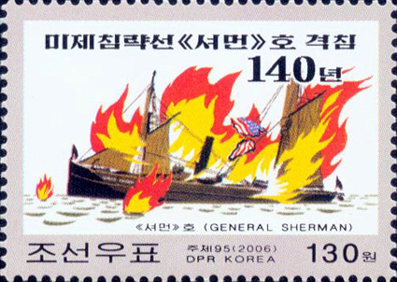
The anti-American philatelic tributes began appearing in earnest once again in the early part of the 21st century. A single stamp for the “Period of Joint Anti-U.S. Struggle” appeared on July 27, 2005 (Scott #4446) picturing a Korean soldier, U.S. POW’s, a military cemetery, and military vehicles. The 80th anniversary of the “Down With Imperialism Union” was commemorated on February 9, 2006 with a single stamp (Scott #4482) and the 140th anniversary of the Korean sinking of the U.S. patrol boat General Sherman was marked with a stamp on September 2 of that year (Scott #4629). A stamp released on June 25, 2008 celebrated the 40th anniversary of the capture of the USS Pueblo (AGER-2) which is still held by North Korea today and officially remains a commissioned vessel of the United States Navy (Scott #4759). Since early 2013, the ship has been moored along the Potong River in Pyongyang, and used there as a museum ship at the Pyongyang Victorious War Museum. Pueblo is the only ship of the U.S. Navy still on the commissioned roster currently being held captive.
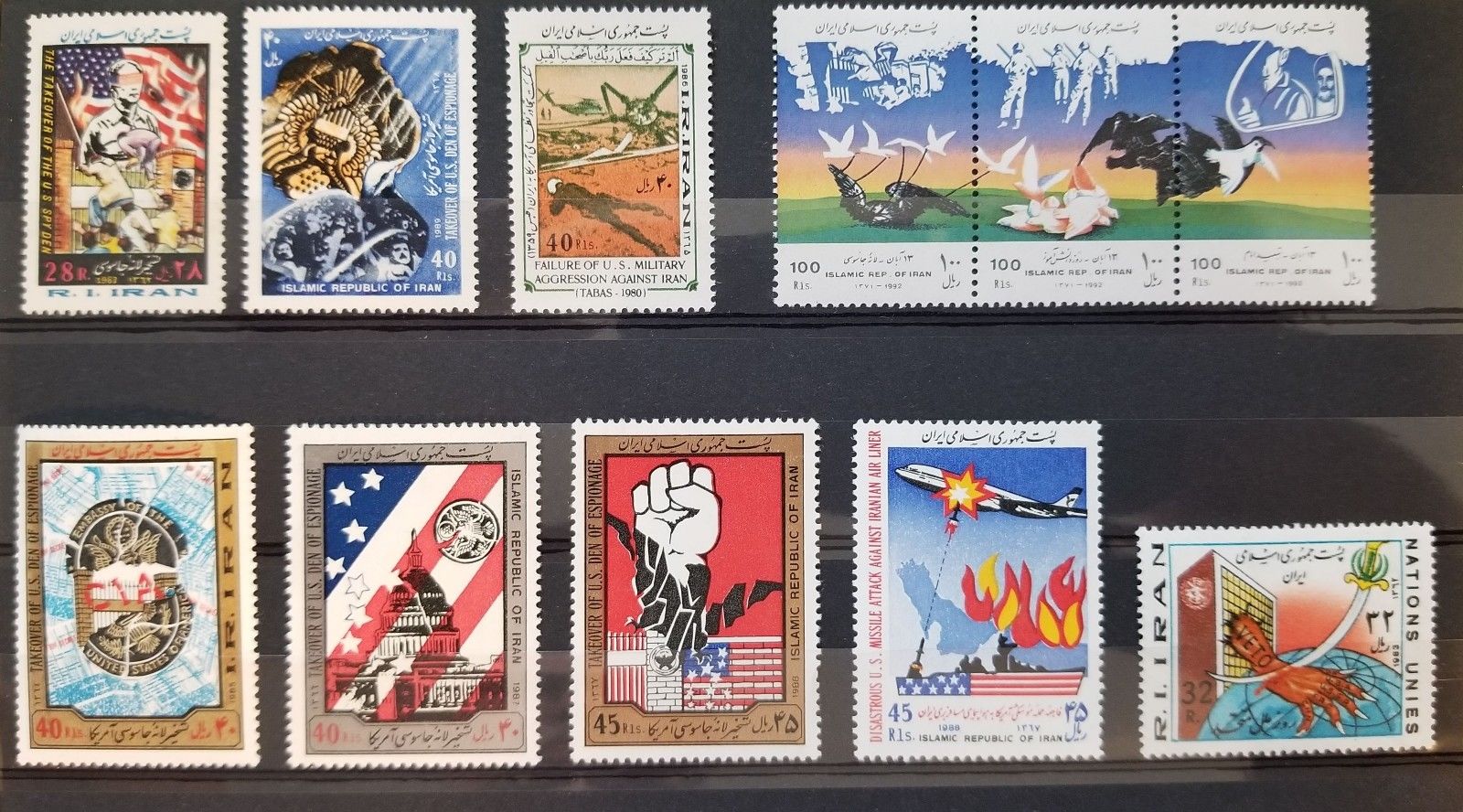
North Korea certainly isn’t alone in it’s issuing of anti-American propaganda stamps with releases by nations such as Libya and Iran immediately springing to mind. It is an odd topical for an American patriot such as myself to collect but I do find them interesting. I suspect that one of North Korea’s upcoming issues will commemorate Kim Jon-un’s meeting with President Trump at the Singapore Summit, a complete reversal from all that has come before. The world is indeed changing, even philatelically.






One thought on “The Final North Korean Anti-USA Month?”